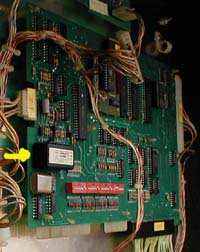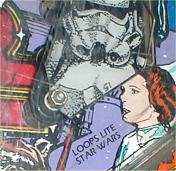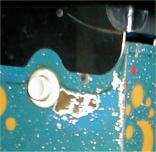How to check a pinball machine you want to buy
So you want to buy a pinball machine, but don't know anything about them ? I'll help you so you at least have some idea what to look for. Once you have checked everything you will have a better idea of the quality of the game.
Buying a used pinball machine can be compared to buying a used car. You can be lucky and find one which never breaks down, or have bad luck and get one which looks great but breaks down all the time. Some games are known to have more problems then others. But on average, a clean, well maintained game will be the best way to go..
You are looking for a game which works fine (or needs minor repairs), but which looks good. This means (a bit of) dirt is ok, you can clean it yourself, but you want as little wear as possible. Not only wear of the paint, but also on things like plastic ramps. (it all depends on what you want of course, maybe you don't care about the cosmetics of a game and are happy with your cheap game with a playfield worn through the paint and showing bare wood, as long as gameplay is fine)
I cannot say if you should or should not buy a certain game. I can only advise you what to do. Everything is relative. What do you want ? A perfect game ? Or a game which works and you don't care about the cosmetics ? It depends on the price of the game. Just don't pay a very high price for a wreck..
Also take a look at my other page which describes how to see if a game works 100% or has problems.
Play the game. Try to activate all features. Check if gameplay is like you expect it to be. Is everything working ? If a coil stays energized all the time, immediately turn off the game and disconnect the coil. Find the problem, or you will burn the coil ! btw, only switch the game on, if the owner says/knows it works !! Don't just switch on a game which i.e. has been in storage for a long time or you don't know if it works !!
 Check the batteries. Solid State games have batteries on them, to remember
high scores and settings. Batteries start to leak. Leaked batteries are not healthy for pcb's.
So first thing to do when you buy a pin, is to check if the battery has leaked.
On old Bally/Stern games, the battery is at the bottom (middle) of the cpu board
(top left in the backbox). Just cut off the battery.
Check the batteries. Solid State games have batteries on them, to remember
high scores and settings. Batteries start to leak. Leaked batteries are not healthy for pcb's.
So first thing to do when you buy a pin, is to check if the battery has leaked.
On old Bally/Stern games, the battery is at the bottom (middle) of the cpu board
(top left in the backbox). Just cut off the battery.
Gottlieb games have a DataSentry battery (it's a black box, yellow arrow in picture)
on their left side of the cpu board
(top right in the backbox). Unsolder it. Williams games have 3 AA batteries in a holder.
Replace batteries with new ones. If there is damage, neutralize with an acid-solution and
replace the components. If you don't know anything about electronics, stay away from games
with battery damage, as they will fail over time (or be prepared to learn how to fix them
or find someone who does).
Check game-specific parts. While new rubbers and other generic parts can be found without problems, this is not the case for game-specific parts. Certain parts can still be ordered from the USA, but they'll cost you (shipping and handling to Europe usually costs more than the part itself). Most parts are just not available anymore, unless someone 'parts out' a machine. Most recent games have at least one thing on their playfield, which is game specific, but has an important function on gameplay. Examples of these are the talking head on Funhouse and Road Show, the Path of Adventure on Indiana Jones, and so on.. Usually the game is smart enough to change its rules so it can still be played, but you are missing part of the show. So be sure to check if these things work fine. If they don't work, it can be a difficult decision. Maybe they need a good cleaning. Maybe an almost impossible to find part has broken off and is missing. Best thing to do is to see if anything is missing, and check for availability first of these parts and then decide if you buy the machine or not. Yes it may be possible you are not able to repair this part yourself, and you'll end up with a machine which will not play like it was intended to. Can you live with that ? Or are you willing to spend like another $500 for parts and waste 6 months looking for these parts ?
Check all plastics. If they're broken (or missing), does it matter to you ? Always try to buy a machine which is cosmetically ok (as this will hold its value more). But don't forget you buy a machine to play it, not to just look at it. If all plastics are broken and you don't like how to machine looks, search for a better one. But if it plays fine and the price is right, consider it. If it's just a few corners chipped, which you hardly see, live with it. If you can't find plastics for sale, you can also try to make replacement plastics yourself, scans are available for some machines. Slingshots plastics often have broken corners. Luckily slingshots plastics are still available for almost every game. Other plastics are harder to find and usually are only sold in a full set of plastics which is more expensive.

Check the paint for wear. First check the cabinet, is it ok ? Does it have large scratches ? Missing paint (chipped) ? If yes, can you live with them, or can you touch them up yourself ? Then check the playfield. Ideally the playfield should have no wear at all, or very little wear which you can touch up yourself. Check high-wear areas, like kickout holes, saucers, and around jet bumpers and slingshots. On older games, check if the game has 'ball swirl marks'. These are fine black lines caused by dirt getting in cracks in the paint. Normally these will not go away with cleaning. Are they annoying to you ?
When checking the cabinet for wear, check the area near the flipper buttons. The picture shows a 30 year old pinball machine with over 70000 plays on the meter. However, I've seen 7-year old games who also had wear like this !! If the game is worn like this, or has been touched up, you have a game with a large amount of plays, so expect all (moving) parts to have wear.

Check for cracked ramps. Most recent games have (clear) plastic ramps. These can break, certainly at the entry/exit and in bends. Replacement ramps are difficult to find, and usually expensive. It is possible to repair cracked ramps, or buy/make metal protector kits for them if they're broken at the entrance. Also check how clear the ramps are. Most of the time they won't be clear because of the dirt, but also because they're worn a bit. No matter how much you clean them, you won't get them clear again (unless you use the blowtorch method - don't ask). So do you buy the game like this, or do you continue looking for a better looking one ?

Check score displays. On old games: are they still bright ? Do all segments light up ?
- Bally/Stern games hardly have any problems and it isn't difficult to find a (cheap) replacement for these.
- Williams System11 games often have dead displays and these are more expensive.
- Blue Gottlieb displays don't fail often.
On new dmd-games: check the dmd-screen.
It must be bright, all lines/dots must work, and it may not have dark or fuzzy spots !
A new DMD is expensive so be sure to check the price of those. Missing lines can maybe
be solved if they're just bad contacts, dmd's with fuzzy spots have to be replaced or they
can stress your power board and damage this too. I personally stay away from pinball machines
with a bad dmd, because usually operators ask the same price for one with a good dmd
as one with a bad one. So just leave this machine and look for another one with a good dmd.
(or convince the operator to replace the dmd with a good one, or give you a discount
so you can buy a new dmd).
- Bally/Williams DMDs are available but expensive (over $100 in the USA, even more in Europe). If the dmd power board is damaged you'll have to buy a new one or fix it using the DMD-HV board.
- Sega/Data East used other sizes of DMDs (large and small), these are (very) expensive and may be difficult to find.
Data East games have specific problems which may look like a broken dmd, while it is just a bad fuse or bad resistor. On these games with an extra small display (Checkpoint to Batman), check resistor R95. This is a 33k 1/2 watt resistor.
System11 games with alpha-numeric displays also have a similar problem that often occurs: resistors R1 and R4 on the power supply board often fail. These are 39k ohm 1 watt resistors. When they're broken the displays will not have +/-100 volts. It's best to always replace them, sometimes they don't completely fail but cause your dmd to have missing segments. On WPC games with alphanumeric displays (like Funhouse) these are resistors R48 and R49.
Do the self-tests. All solid state machines have self tests. Check the manual on how to initiate them and what they do. Most of the time you just have to press a button inside the coin door to advance through the tests. Tests will light up all lamps, test the score displays, fire all solenoids, and test all switches. Light bulbs are no problem, these can be changed. Score displays can also be changed, but are more expensive. If they're not or badly working, try to find the price of a replacement part. Or decide if you can live with a game with a bad score display. Listen through the solenoid test if all solenoids are working. Usually their id-number will be shown on the display, check with the manual (or the paper on the inside of the cabinet) which coil has which number. If some are not working, try to find out why ? (loose wire, bad connector, or problem on a pcb ?) If a coil doesn't work, try to move it by hand. If it's hard to move, the coil may be burnt. You'll have to replace the coil, probably the whole assembly (the metal part which goes through the coil, and solve the problem which made the coil burn in the first place. In the switch test, touch every switch and targets to see if it gets activated. Same thing here, if some don't work, try to find out why. They can be worn and need to be replaced, it can be a loose wire, bad connector, or a problem on the pcb. If more then one switch doesn't work, check with the switch matrix in they are in the same row or column, this may give an indication why they all don't work. Replacement targets can be bought, but keep in mind that they may not look the same as the original ones. On recent machines the machine will say which problems it has (like switches not activated) when you open the coin door. This is also indicated by a 'credit dot' (Credits 0.) on Williams/Bally dmd-pins.
Check connectors. Inspect all connectors visually. Check if they have brown burn marks (or are burnt and falling apart when you touch them). On old Bally/Stern pins, check the connectors on the power board (the board with all the fuses). On recent Bally/Williams pins, check the GI (global illumination) connectors (J120 and J121, also check J109, left bottom of the large board in the middle). Replacement connectors are available, maybe you'll have to solder new pins too.. There are known upgrades to do on old bally/stern pins to solve the problem. While burnt connectors aren't a major problem on their own, they are a good indication to know if a machine has been used/powered on for a long time. These problems only happen when a machine is powered on for a long time (all day for months/years). If someone wants to sell a machine as home-use, low play, and has burnt connectors.. then it hasn't been home-use or has been on all day long so HUO doesn't make much of a difference.. It's also an indication that electronic parts may also have been stressed and can fail soon, so if you know nothing of repairing pins, better look for one in a better condition. Also check the pcb's visually (especially the powerboard) to see if they're ok and don't have burn marks on them (and if they do - check closely if the traces are still ok)
Is the game clean ? How clean is the game exactly ? And more specific, look also at the underside of the playfield and the inside of the cabinet. This is also a good indication for the number of games and how well it's been maintained. Beneath a dirty playfield may be a nice one which needs a good cleaning. But you will have to clean the game totally (removing every assembly and cleaning it) or the dirt will come back very soon. Whilst you are cleaning the game, replace all rubbers. Your game will look and play a lot better ! A clean playfield but cabinet which is inside black by the 'pinball dirt', means the previous owner has cleaned the playfield regularly, but the dirty cabinet indicated the game does have a lot of games on it.. If the game is really clean, it really has a low number of plays on it, or someone has already cleaned it very well..
Check the backglass. New games have a plastic (translite), older games have a painted glass. Temperature changes and humidity will cause the paint to loose from the glass (flaking). That's a bad sign. Replacement glasses are very difficult to find and can be expensive. A broken or missing backglass is one of the main reasons why most EM pins don't get restored but parted out btw.. you have to be very lucky to find a replacement glass. So if you buy a pin without a backglass, make sure at least the pin is working fine, or it's almost worthless (just for parts).
Buying a game which has been in storage for a long time. Not a lot to say about these ones. Check out where it has been stored and overall condition. Humidity is what you're looking for. If the game has been stored in a dry place and looks good, it'll be fine probably. Check for rust and corrosion on metal parts. EM games may have parts which have become stuck, certainly if someone has been so 'smart' to lubricate them.. Solid State games may have problems with their cpu boards (certainly if the pins of the chips show corrosion !) or leaked batteries. Be careful when you power them up, don't expect them to work from the first time, and they may need a lot of work and replacement parts. Unless they're cosmetically in very great shape, or are rare games, I would not pay a lot for games which have been stored for many years and are not working. Btw, if it's after dusk, have a flashlight nearby when you're going to power up a pin for the first time.. you don't want to search the fuse box in your house in the dark because all fuses blew..)
Do you get any extras. Pinballs machines were shipped with a manual (sometimes even more than one: a game specific manual and general schematics). Do yo get them with the game ? If not, you may want to consider finding out first if you can still acquire a manual, before buying the machine.. Do you get any other replacement parts ? New rubbers are cheap and available, spare coils and game-specific plastics are more interesting to get. Do you have to pick up the game yourself, does it come delivered and installed at your house ? Any warranty ?
